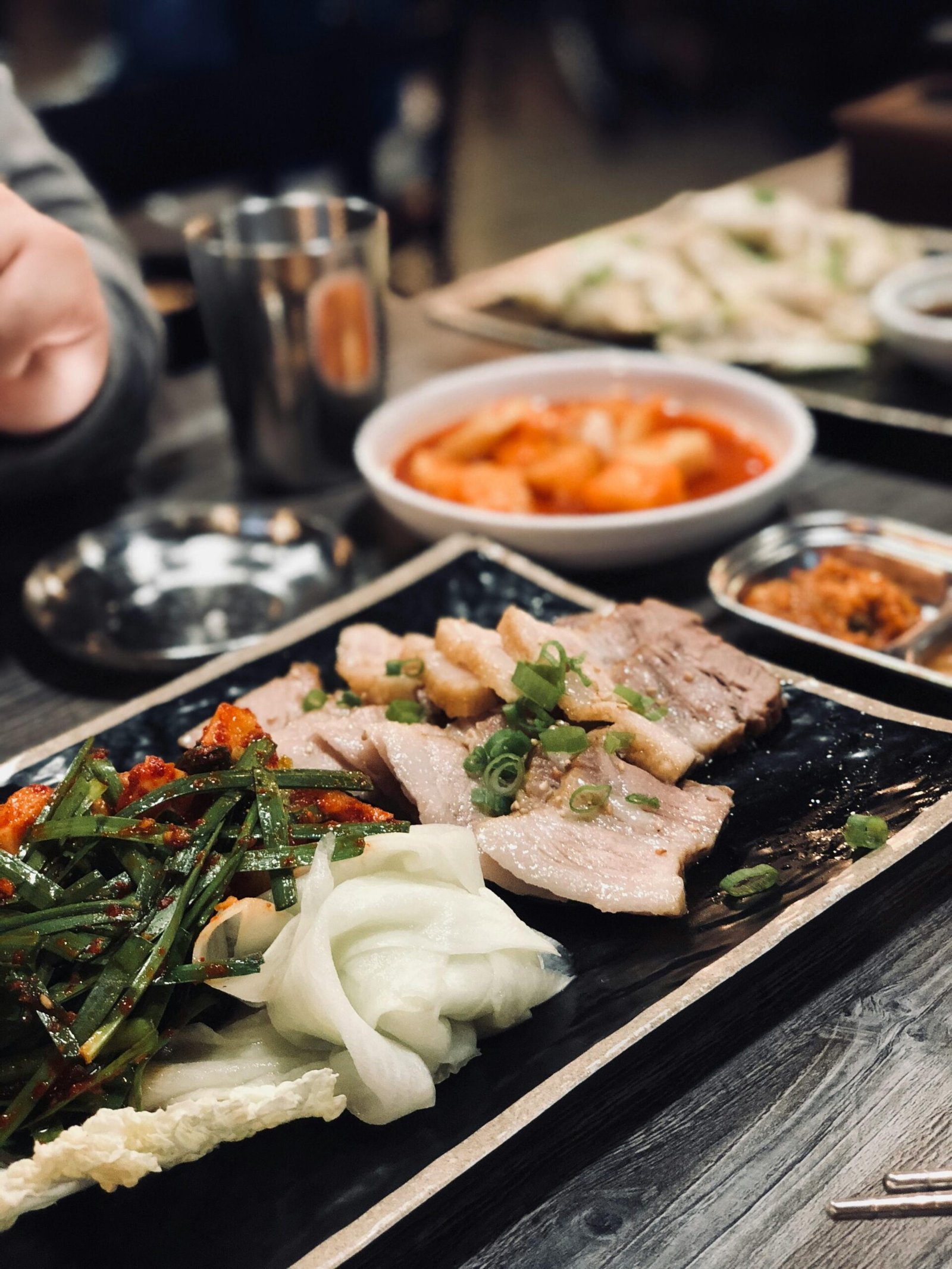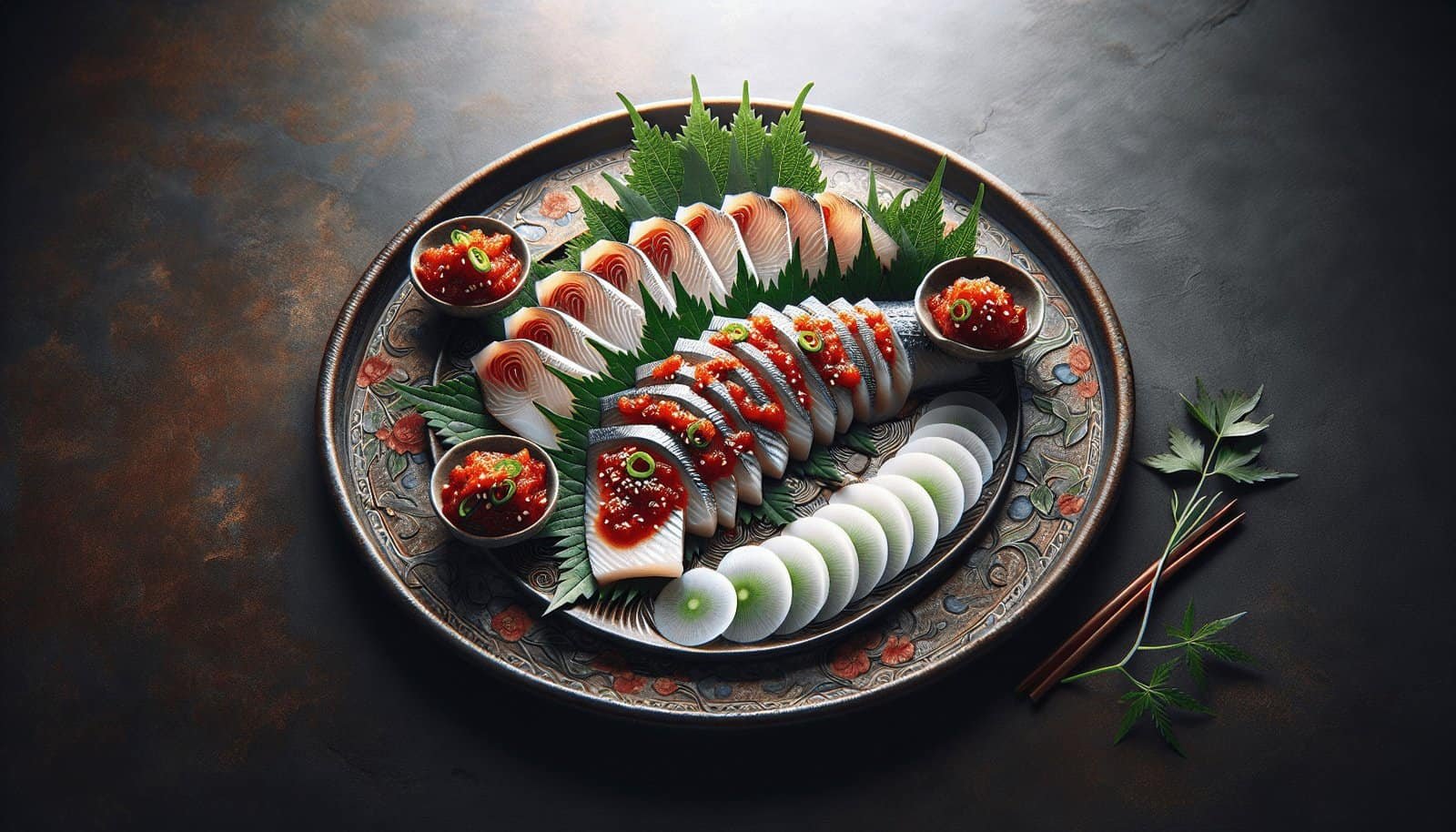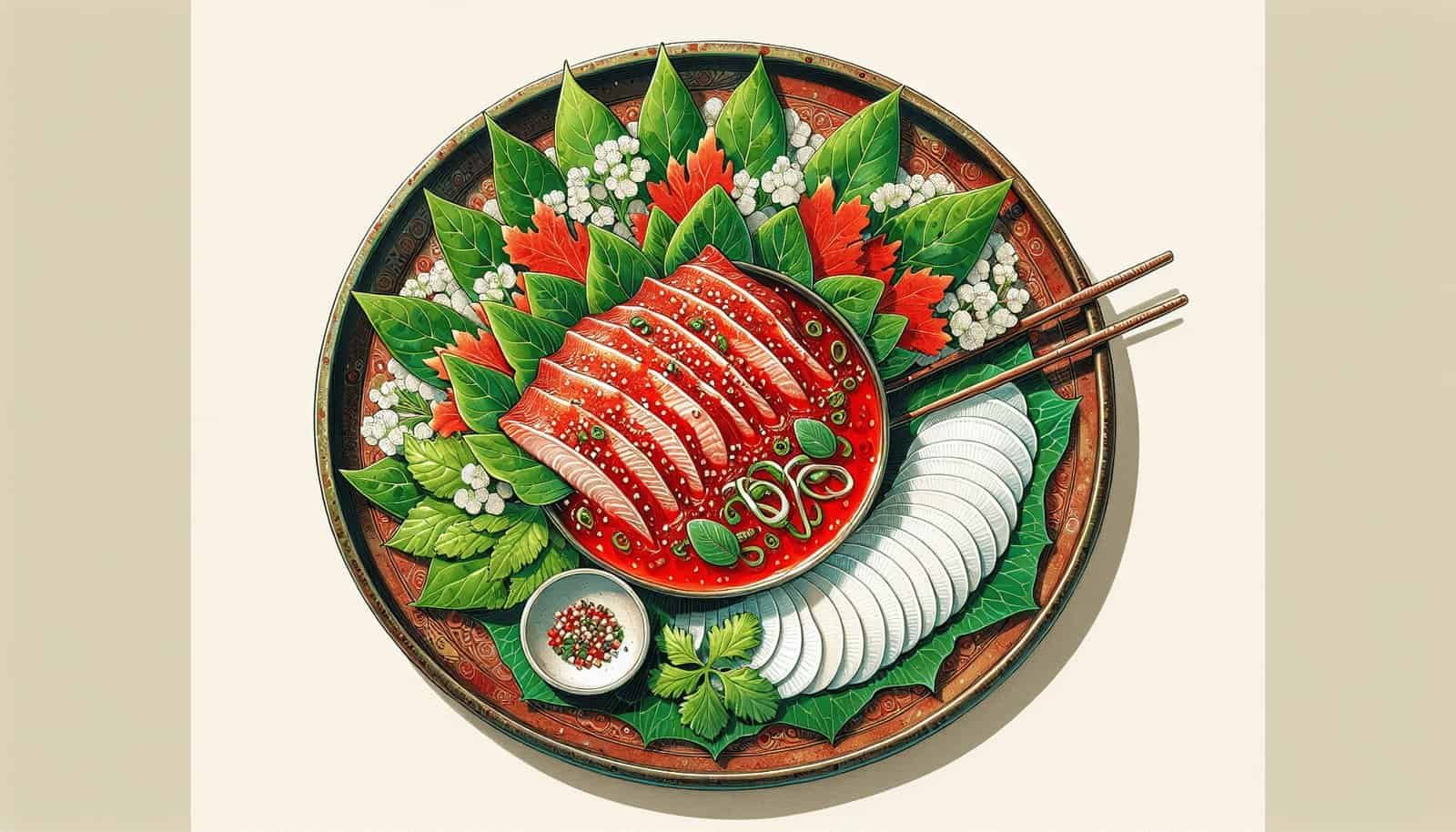Have you ever wondered how to properly prepare and enjoy traditional Korean spicy raw fish, also known as hwe? If you’re a lover of seafood and craving something new, hwe might just be the dish you’ve been searching for. Hwe, pronounced “hway,” is a Korean delicacy that offers a beautiful combination of fresh raw fish and spicy seasoning.
In this article, you’ll learn everything you need to know about preparing and enjoying hwe, from choosing the right fish to pairing it with perfect sides. So, roll up your sleeves and get ready to embark on a culinary adventure that promises sensational flavors and delightful textures.

What is Hwe?
Hwe is a Korean dish consisting of raw fish, typically served as thinly sliced pieces similar to Japanese sashimi. Unlike sashimi, however, hwe is often dipped in a spicy chili paste known as gochujang, mixed with vinegar, soy sauce, and other ingredients. Koreans usually enjoy hwe with a variety of side dishes, known as banchan, which add layers of flavor and texture to the experience.
Choosing the Right Fish
Selecting the freshest and safest fish is crucial when preparing hwe. Generally, white-fleshed fish like flounder, halibut, and rockfish are preferred because of their firm texture. However, other types of fish such as tuna and salmon can also be used.
Freshness Matters
When selecting fish for hwe, freshness is paramount. Look for:
- Clear, bulging eyes
- Bright red gills
- Firm, resilient flesh
- A clean ocean scent without any fishy odor
Types of Fish Commonly Used
| Fish Type | Description | Flavor Profile |
|---|---|---|
| Flounder | Firm, lean with a subtle taste | Mild, sweet |
| Halibut | Dense flesh, slightly firmer than flounder | Mild, slightly sweet |
| Rockfish | Tender with a fine, flaky texture | Mild, delicate |
| Tuna | Dark, dense with a meaty texture | Rich, pronounced |
| Salmon | Soft, oily with vibrant color | Rich, buttery |
Preparing the Fish
Proper preparation ensures that you fully enjoy the textures and flavors of hwe. Here’s a step-by-step guide to filleting your fish for hwe:
Filleting the Fish
- Clean Your Fish: Rinse the fish under cold running water to clean off any impurities.
- Remove the Scales: Use a scaling tool or the back of a knife to remove scales. Start from the tail and move towards the head.
- Gut the Fish: Make an incision along the belly from the anal vent to the head. Remove the innards carefully, ensuring not to puncture the entrails.
- Fillet the Fish: Make a cut behind the gills down to the backbone. Carefully run your knife along the backbone toward the tail to separate the fillet from the bones.
- Remove Pin Bones: Use tweezers or pliers to pull out any remaining pin bones from the fillets.
Slicing the Fish
Once you have filleted your fish, it’s time to slice it. Using a sharp knife, cut the fillets into thin, bite-sized pieces. Traditionally, hwe slices are about the thickness of a coin, which allows them to absorb the maximum amount of flavor from the dipping sauce.
Preparing the Dipping Sauce
A delicious dipping sauce is a cornerstone of a good hwe experience. The most common sauce is cho-gochujang, a spicy, tangy mixture that complements the fresh taste of the fish perfectly.
Cho-Gochujang Recipe
Here’s a simple recipe to prepare cho-gochujang:
Ingredients
- 3 tablespoons gochujang (Korean chili paste)
- 1 tablespoon rice vinegar
- 1 tablespoon sugar
- 1 teaspoon soy sauce
- 1 teaspoon sesame oil
- 1 clove garlic, minced
- 1 teaspoon toasted sesame seeds
Instructions
- Mix Ingredients: Combine gochujang, rice vinegar, sugar, soy sauce, sesame oil, and minced garlic in a bowl.
- Stir Well: Ensure all ingredients are well mixed until the sugar has dissolved.
- Garnish: Sprinkle toasted sesame seeds on top.
Taste the sauce and adjust according to your preference. You can add more vinegar for tanginess, more sugar for sweetness, or more gochujang for extra heat.
Other Dipping Options
While cho-gochujang is the most popular, there are other dipping sauces you might enjoy:
Soy Sauce-Based Dipping Sauce
- 2 tablespoons soy sauce
- 1 tablespoon rice vinegar
- 1 teaspoon sugar
- 1 green onion, finely chopped
- 1 teaspoon sesame oil
- 1 clove garlic, minced
Combine all ingredients in a bowl and mix well. This light and savory sauce is a great alternative if you prefer something less spicy.

Side Dishes (Banchan)
Traditionally, hwe is served with a variety of side dishes, known as banchan, which enhance the meal with additional flavors and textures. Here are some banchan that pair well with hwe:
Common Banchan for Hwe
| Banchan Name | Description |
|---|---|
| Kimchi | Fermented cabbage with spicy seasoning |
| Muchae | Seasoned radish strips |
| Gyeran Jjim | Steamed egg custard |
| Miyeok-muchim | Seaweed salad |
| Oi Muchim | Spicy cucumber salad |
Kimchi
Kimchi is a staple Korean side dish made from fermented cabbage and radish, seasoned with chili powder, garlic, ginger, and other spices. Its tangy, spicy flavor complements the fresh raw fish perfectly.
Muchae (Seasoned Radish Strips)
Muchae consists of thinly sliced radish strips that are lightly seasoned with vinegar, sugar, and a touch of chili powder. It’s crunchy and refreshing, serving as a perfect palate cleanser between bites of hwe.
Gyeran Jjim (Steamed Egg Custard)
This is a soft and silky egg custard dish that’s steamed in a small bowl. Its mild flavor and smooth texture balance out the spiciness of the hwe dipping sauce.
Miyeok-muchim (Seaweed Salad)
Miyeok-muchim is a flavorful seaweed salad with a dressed mixture of soy sauce, sesame oil, vinegar, and sometimes a touch of sugar and garlic. It’s refreshing and adds a delightful umami flavor.
Oi Muchim (Spicy Cucumber Salad)
Oi muchim is a spicy and crunchy cucumber salad that’s seasoned with gochugaru (Korean red chili flakes), garlic, and sesame oil. It offers a fresh and invigorating contrast to the meal.
How To Serve Hwe
Serving hwe correctly is just as important as its preparation. A proper presentation not only enhances the dining experience but also highlights the dish’s aesthetic appeal.
Plating the Fish
Arrange the sliced fish in an artful pattern on a chilled plate. Alternating colors and shapes can make the presentation more attractive. Ensure the slices are easy to pick up with chopsticks.
Adding Garnishes
Garnishes like fresh shiso leaves, thinly sliced lemon, or edible flowers can add a touch of elegance to your dish. Additionally, thin slices of veggies such as daikon radish and cucumbers can be placed around the fish for added aesthetics and freshness.
Presenting the Sauces
Serve the dipping sauces in small, individual bowls. This allows guests to dip each bite without double-dipping, maintaining hygiene and ensuring that everyone can enjoy the sauces to their liking.
Arranging the Banchan
Place the banchan in small, separate dishes around the main plate of hwe. This traditional Korean setup encourages sharing and sampling, enhancing the communal dining experience.

How to Eat Hwe
Part of the pleasure of eating hwe is knowing how to enjoy each bite fully. Here’s a suggested way to savor this delicacy:
- Dip the Fish: Pick up a slice of fish with your chopsticks and dip it into your preferred sauce.
- Add a Side: Top the dipped fish with a piece of garnished veggie or banchan.
- Consume: Immediately place the whole combination into your mouth to enjoy the blend of flavors and textures.
- Cleanse Your Palate: Between bites, cleanse your palate with a sip of water or a bite of muchae or oi muchim to enjoy a fresh flavor with each new slice.
Tips for a Safe and Enjoyable Hwe Experience
Eating raw fish carries some inherent risks, particularly related to parasites and bacteria. However, these risks can be minimized with proper handling and preparation.
Ensuring Safety
- Purchase from Reputable Sources: Always buy your fish from a trusted fishmonger or a shop that sells sushi-grade fish.
- Check for Certification: Look for sellers with certification from health authorities, ensuring the fish is safe for raw consumption.
- Refrigerate Properly: Keep the fish at a temperature below 40°F (4°C) until you’re ready to prepare it. Ideally, you should prepare and eat it on the same day of purchase.
- Inspect Thoroughly: Always inspect the fish for any signs of spoilage. If the fish smells off or has a slimy texture, do not use it.
Serving Fresh
To ensure the best taste and safety, serve the hwe immediately after slicing. The fresher the fish, the more enjoyable the experience will be. If you must prepare it in advance, keep the sliced fish covered and refrigerated until serving time.

The Cultural Significance of Hwe
Hwe is more than just a dish; it carries cultural significance in Korea. Eating hwe is often associated with special occasions such as feasts, family gatherings, and celebrations. It represents freshness, health, and the communal aspect of Korean dining, where sharing food is seen as an expression of togetherness and love.
Regional Variations
Different parts of Korea have their variations of hwe, influenced by the local fish available and regional tastes. For instance:
- Jeju Island: Known for mackerel and amberjack hwe.
- Busan: Famous for flounder and rockfish hwe often paired with spicy sauces.
- Seoul: Offers a more eclectic mix due to its metropolitan nature, incorporating multiple types of fish and sauces.
Conclusion
Hwe is not just a meal; it’s a delightful experience that brings together freshness, flavor, and cultural richness. By carefully selecting your fish, preparing it with precision, making delicious dipping sauces, and serving it with complementary banchan, you can create an exquisite Korean dining experience right at home.
So, now that you know how to properly prepare and enjoy traditional Korean spicy raw fish, why not take the plunge and try it out? Whether you’re preparing it for a special occasion or just to enjoy on a regular day, hwe promises a unique and exciting culinary adventure.
Remember, the key lies in the details – select the freshest fish, perfect your dipping sauce, and don’t forget to enjoy every bite. Happy cooking!

